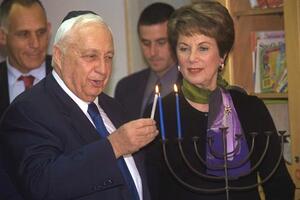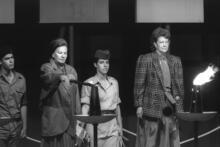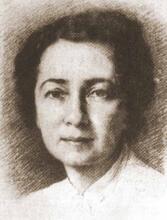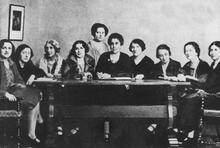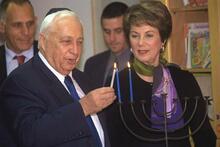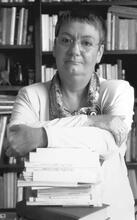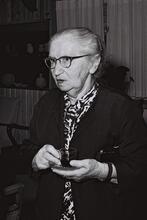WIZO in Israel: 1970-2005
The Women’s International Zionist Organization works to improve the status of women in all areas—family, work, society, political life, and legal matters. Since WIZO perceived itself as a partner in building Israeli society, its initial major concern was with traditional areas considered appropriate to women, such as caring for new immigrants and children, women, and the elderly. From a feminist viewpoint, the organization has advanced considerably, making subjects such as gender equality a central topic from early childhood (education for equality in day-care centers) and advocating equal opportunities for girls and women. WIZO’s Study Center for Leadership, founded in 1982, can serve as an example of WIZO’s ability to lead dynamically, renew itself, and respond to its own and Israeli society’s changing needs.
A review of the Women’s International Zionist Organization’s (WIZO) achievements and contribution to building Israeli society reveals the number of areas in which the organization has been involved throughout its existence, investing great effort in them according to society’s changing needs: the status of women; child care from infancy to adolescence; care of the elderly; community work; and immigrant absorption. Overall, the organization’s major activity is directed toward improving the status of women in all areas—family, work, society, political life, and legal matters. A survey of women’s advancement in the country reveals the enormous changes that occurred and, together with them, flexibility and change within the organization in order to advance women in a more clearly feminist manner.
WIZO as a movement adapted itself to changing needs even as it occasionally led some of the changes. From a movement once characterized by traditional thinking about women’s important role in home and family (as expressed in a speech by Rachel (Cohen) Kagan [1888–1982] in the First Lit. "assembly." The 120-member parliament of the State of Israel.Knesset), it became more dynamic, fighting for women’s rights and status in society. This is apparent in the recent emphasis on women’s leadership (the establishment of the Midrasha ha-Ra’ayonit [Rachel Kagan Study Center for Leadership]), intensive work on legal issues related to women’s status and rights within the family, participation in various coalitions against domestic violence, the opening of two shelters for women suffering domestic abuse and centers for the prevention of family violence, and assistance to girls at risk.
From a feminist viewpoint, the organization has advanced considerably, making subjects such as gender equality a central topic from early childhood (education for equality in day-care centers) and advocating equal opportunities for girls and women. In this way, the organization preserved its values and its relevance in a changing and dynamic Israeli society.
Women’s Status
The minutes and reports of WIZO’s legal centers and its Council on the Status of Women (headed by Tanya Levenfisch-Shtreifler) indicate that both entities have been instrumental in feminist activity. The proposals presented to WIZO’s Fifteenth Annual Conference in 1974 included:
- A demand that the Ministry of Education train teachers, especially kindergarten teachers, to engage in activities designed to change the image of girls and women, as well as that of boys and men, regarding roles in the family, society and work and to inculcate the concept of equal roles from childhood on;
- A proposal to establish family courts comprised of experts such as psychologists, sociologists, social workers, and lawyers;
- A resolution to strive to grant homemakers the status of employed workers, e.g. by providing insurance for accidents in the home;
- A recommendation to establish women’s councils within municipal councils and local authorities, designed to improve municipal services and quality of life;
- A request that the Hebrew Language Academy find a word to replace ba’al (the Hebrew word for “husband,” which also means “master” or “one who has sexual rights”) in all official publications;
- A request that the mother’s name be included in all official forms in which only the father’s name had hitherto been requested.
Practicing what it preached, WIZO was the first national women’s organization to join the Israel Women’s Network in advocacy activities, with the result that many of the above recommendations have indeed been implemented. WIZO also ensured gender equality throughout its entire educational system.
WIZO made a major contribution in bringing the subject of domestic violence to public awareness. On July 14, 1976, when the subject of women physically abused by their husbands was raised in the Knessey by MK Marcia Freedman (b. 1938), the chairperson of the Independent Socialist faction, Freedman based herself on the statistics of WIZO’s legal bureaus for family affairs. She claimed that WIZO was the only organization sensitive to the subject and the only one that responded to her queries.
At the time, WIZO had 24 bureaus working in a total of 123 locations. According to statistics from the southern region, eighty to eighty-five percent of those who contacted the bureaus were women who suffered from domestic violence. In Tel Aviv, forty percent were battered women and in the north the percentage reached fifty to fifty-five. In 1975–1976, 1500 women contacted the bureau for legal help in obtaining a divorce.
Later, WIZO opened three women’s shelters, together with three centers for the prevention of domestic violence, where violent men receive treatment. A unique project for shelter graduates, called “Halfway Along,” was also established, which included preparation and training for independent life.
WIZO’s Council on the Status of Women actively promoted the integration of women in local government. In 1976 the Council issued a “Call to Action” that included the rationale behind this initiative; non-political women’s organizations followed WIZO’s lead. The main demand was for fair representation of women in local authorities and the depoliticization of local government. A complementary measure was a request to Knesset faction chairpersons to pass a law separating Knesset election dates from those for local authorities (Greenberg and Herzog 1978). At the Fifteenth Conference it was decided to recommend that all the branches in the country join the Le-Ma’an lists for the local authority and municipal elections. However, in accordance with the organization’s by-laws, WIZO members who were prominently active in its branches and who presented their candidacy for party lists had to resign their WIZO membership because of the organization’s apolitical nature. This entailed a difficult dilemma for feminist activists with a high degree of political awareness, who felt the demand was hypocritical. Precisely when they tried to realize the goal of advancing women to decision-making positions—the very goal for which the organization had educated them—they were compelled to leave the organization.
The problematic nature of the struggle for leadership positions in society, as opposed to women’s image as service providers, was evident throughout the organization’s ideological progress. Usually the traditional women had the upper hand (Greenberg and Herzog 1978), which prevented the organization from “taking off” in society. In consequence, it lost some potential younger members, who wished to have careers and attain powerful positions in all fields, including politics. In an effort to preserve its independence of political parties, World WIZO opposed political involvement. As a result of its internal struggles and lack of clarity on socio-political involvement, WIZO lost some of its political strength.
There is no doubt that the many discussions on socio-political and feminist issues that took place within the organization reflect the dilemmas that women in Israeli society must deal with in their struggle for a career and for equality in society. In the end, the feminist view prevailed and the organization proceeded to the center of the struggle, working for women’s advancement in every field. WIZO joined in advocating several important laws passed in the last decade of the twentieth century. These include a minimum penalty for men found guilty of abuse; prohibition of dismissal of women undergoing fertility treatments; and promotion of egalitarian labor laws, together with a demand for enforcing them.
WIZO is a prominent member of the coalition of women’s organizations that collaborate on a number of issues, such as opposition to pornography on cable television stations; assistance to agunot,[link to new entry on agunot] via the International Coalition for Agunah Rights (ICAR); and promotion of pre-nuptial agreements, which might provide a solution to potential agunah problems.
It is thus clear that WIZO adopted the feminist notions that prevailed in the final decade of the twentieth century and in many respects became a leading proponent of them, thus creating a kind of new identity for itself.
Childcare and Education
From its founding, WIZO concentrated on child care and education. The work that the founders began modestly in Jerusalem (Greenberg and Herzog 1978) later became a large-scale institutional endeavor that included care for young children, youth in distress, and young girls at risk.
WIZO was the first women’s movement to open day-care centers and playgroups for very young children, allowing thousands of mothers, both new immigrants and veteran citizens, to work outside their homes. The network of day-care centers grew to 170; in addition there are seven multipurpose centers and four family units that take in children from dysfunctional homes. In the past, there were three other institutions that cared for babies and prematurely born infants: the Mother and Child Center in Tel Aviv, the Baby Home and Child Center in Jerusalem, and the convalescent home for babies in Yokne’am.
In 1972 the WIZO board report listed ten agricultural and vocational schools, eighty-seven day-care centers, playgroups, and kindergartens, fifty-one youth clubs, and an educational-vocational center for girls in Jerusalem. At that time WIZO cared for 60,000 children and youth. As early as 1972 three day-care centers were opened on Air Force bases and four more were opened in absorption centers in response to pressure by municipalities and local authorities. Aware of social needs, WIZO today opens day-care centers near factories, hospitals, and Israel Military Industries, thus strengthening women’s status by enabling them to go to work and support their families.
Immigrant Absorption
Since WIZO perceived itself as a partner in building Israeli society, its major concern was with traditional areas considered appropriate to women, such as caring for new immigrants and children, women, and the elderly. Consequently, departments were established to deal specifically with these issues and the organization focused on providing services to Israeli society on a voluntary basis.
The board’s 1962 report shows that one of the chief areas of operation was caring for the various waves of immigration, investing significantly in immigrant absorption. Since immigrants came from many different countries, the patterns of absorption and care varied accordingly. During the 1950s and the 1960s, after the large wave of immigration from Arab countries, WIZO went into action in the transit camps and suburban areas. Most of the work revolved around teaching language and eradicating illiteracy. The immigrants lived in extremely difficult conditions and the percentage of illiteracy was very high. In 1961, some quarter of a million people among the Jewish population were illiterate. Most had never had any education whatever, while some had attended school for one to four years. Two-thirds of them were women. Yet the topic failed to receive comprehensive treatment via the implementation of a national social policy focused on women.
In his 1982 article “Adult Education and Jewish Culture at a Crossroads,” Avraham Tzivyon claimed: “The absorption centers and ulpanim preferred educated people while treating those with limited ability as ‘the desert generation,’ temporary and transient, for whom it was unnecessary to invest systematic educational effort.” The prime victims of this policy were the mothers from Arab countries, most of whom had small children and could not attend school even if they wished to do so.
The contributions of women’s organizations, which worked in this area both professionally and on a volunteer basis, are not documented in the literature about the various agencies engaged in eradicating illiteracy. WIZO went into action in 1957 after David Ben-Gurion appealed to all the women’s organizations in the country. The work was carried out modestly, lovingly, and with complete faith in the idea of enhancing women’s status in the society that was taking shape. A program created together with professionals trained volunteers in conducting home visits (Shachar 2000).
In the wake of inculcating language skills, clubs were built, day-care centers were opened, and connections made with schools to help children with learning difficulties. This was an effort completely by women for women. The goal was to turn the new immigrant women into volunteer activists engaged in consciousness-raising in their neighborhoods and involve them in community projects such as parents’ committees, the Civil Guard, support for families in need and organization of lectures, cultural evenings, and trips for new immigrant men and women.
Another mode of action was the adoption of transit camps and communities near WIZO branch offices and sometimes in more distant places. For example, the WIZO branch in Ramat Gan adopted the distant Lakhish region and the nearby Salmah Gimmel transit camp, and many of the branches did the same. An analysis of immigrant absorption shows the many methods used, depending on the population. Immigrants from Yemen were absorbed through the development of home-based industries, handicrafts, and artisan work, with sale of their work in WIZO stores in Tel Aviv, Haifa, and Jerusalem. Immigrants from Russia were absorbed according to a completely different model, appropriate for western culture. Ethiopian immigrants, with their extremely closed culture, which does not allow sharing one’s distress with “strangers,” required unique and different absorption methods. WIZO’s immigrant absorption work in Israel and worldwide appears in every report of the national and international board but does not receive the coverage it deserves in the history books on immigrant absorption (Shachar 2000). In a WIZO report of 1957, the following sentences emphasize the vision of immigrant absorption and the ingathering of exiles: “We did not and do not give charity. We are not a philanthropic organization. Our program involves rehabilitation, and we help new immigrants become established in the life of the country and the state as citizens with equal rights and obligations.”
In a highly professional manner, WIZO continues to aid the various waves of immigration, with an emphasis on the latest ones from Ethiopia and Argentina and special consideration for those from the Caucasus (National Board Annual Reports, 1960–2002).
Old-Age Homes
Hanna Levin, WIZO’s director in 1977, is to be credited with the idea of establishing homes to care for those elderly members of WIZO who, after some fifty years of volunteer work, were in dire economic straits. First mooted in the 1970s, the proposal was ruled out because WIZO preferred to invest its efforts in children rather than in its elderly members. Yet because other board members, such as world treasurer Miriam Ben-Porat and Shuly Broide, who directed WIZO after Levin, shared Levin’s opinion, it remained on the agendas of the national and international boards of directors. At the same time, WIZO decided to close its prestigious Beit ha-Tinokot Mother and Child Center in Tel Aviv, which treated premature babies, infants, and children of all ages. This decision, taken during the years 1972 to 1980, resulted from research indicating the emotional damage suffered by children in institutions.
Following this research, and also as a result of the Adoption Law passed in the Knesset that allowed these children to be adopted or entrusted to foster families, WIZO decided to close the Mother and Child Center. In its place, they bought four cottages in Herzliyyah and found young families willing to be foster parents to live in them. Each family cared for eight children of varying ages. The children stayed with the families until they reached the age of eighteen and the project was supported by WIZO of South Africa.
It was decided that the large building in Tel Aviv, now empty, would henceforth serve as a home for the elderly members of WIZO. Renovated, it housed more than a hundred independent male and female residents, and thirty-six elderly people in the nursing unit. A volunteer committee manages the home, while high-level care, entertainment, social and cultural activities are provided.
Leadership Development
WIZO’s Study Center for Leadership, founded in 1982, can serve as an example of WIZO’s ability to lead dynamically, renew itself, and respond to its own and Israeli society’s changing needs (Greenberg and Herzog, 1978). The Center’s two main goals were to train the next generation for leadership roles and to deepen the movement’s ideological message among its members in Israel and throughout the world. These combined goals constituted a challenge to those within and outside the organization who were drawn to the professional way the Center operated, with workshops, study days, lectures, and experiential meetings.
A three-stage curriculum was established for WIZO’s young leadership in Israel, i.e. branch chairpersons, deputies, branch board members, and young activists throughout the country. A more advanced level included management and leadership workshops for the national and international boards. Directed by a steering committee comprised of international and Israeli WIZO members, representatives of Tel Aviv University and other advisers, the Center, headed by National Board member Rina Shachar, operated in close cooperation with the NORA Institute, an organization in the forefront of women’s leadership at the time. Hundreds of WIZO members from all over the country were trained at the Center, later serving as a vital leadership reserve for the movement. The Center’s success in drawing young women to work in WIZO by training them for leadership positions was unique and pioneering at the time, providing other women’s organizations with an impetus to follow suit.
In addition to providing training for leadership roles in the organization, the Center focused on imparting the movement’s ideological message to the leadership and the members in Israel and abroad. It dedicated the majority of its study days to focusing its plans on WIZO’s goals, the reasons for establishing the Center and an emphasis on WIZO’s unique activities as a contemporary women’s movement. Additional workshops were scheduled for public-relations workers, whose task was to visit the branches and recruit people to the movement’s ideology. The combination of the two messages—leadership training for women, together with deepening the movement’s message—led to awakening, renewal and a feeling of relevance for the women in the movement. From a sociological perspective, the organization’s initiative corresponded both to the immediate needs and to the aspirations of women in Israeli society who, during the 1980s, were just beginning to attain a feminist consciousness and acknowledge their power (Herzog 2000).
The maturing of WIZO and its awareness of women’s power and strength in Israeli society constituted the implementation of the vision of Rachel Kagan and Tanya Levenfisch. A survey of the Center’s activity over time shows that its graduates achieved leadership roles in the organization, some even attaining respected positions in local government and in the establishment.
In memory of Rachel Kagan the Center holds annual study days on women’s status in society and Kagan’s ideology as a leader, which have drawn the younger and older generations together both in a vision for the future and in respect and appreciation for the organization’s roots and its past leaders.
WIZO’s 1995 initiative to establish a special committee for the advancement of women in politics (spearheaded by Michal Yudin, who later headed the committee) aroused much debate since WIZO is an extraparty organization. However, there was clearly a need to advance women in politics and provide them with the tools necessary for success. After a difficult struggle in the Council, it was decided to establish the committee, but without any funding or administrative provisions. The committee’s goals were to locate talented women with a background in public activity and encourage them to become candidates in elections to the Knesset and to local government. Those women who were chosen as suitable to participate in a course for women leaders would undergo professional training by political and media advisers.
The project’s steering committee comprised academics and representatives of various sectors, including the ultra-Orthodox. The Jewish Agency’s Partnership 2000 provided funding. Since WIZO branches exist all over the country and a large number of women encounter WIZO a great deal in daily life, it was possible to use existing infrastructures in order to advance the project.
The first and largest school opened in Jerusalem; later, centers were established in Beersheba, Ashdod and Kiryat Shemonah. Some three hundred women from extremely varied communities such as the ultra-Orthodox, Arab, Druze and Bedouin sectors have taken the various courses. Some of them have become active in various political parties, but no research has as yet been conducted to measure the success of the program or determine the percentage of women who have entered political leadership.
Facts and Figures
With fifty federations throughout the world, with a total of 250,000 members, WIZO is the largest Zionist voluntary women’s organization, operating hundreds of centers and thousands of branches. Members worldwide maintain constant contact with Israel by means of conferences, an annual seminar for young leaders, a convention every four years and frequent visits. Federations are connected with projects in Israel, and members in each federation donate their work to Israel. Today, every single federation in the world has a project in Israel, and some have several.
World WIZO provides maintenance and financial support to schools, youth clubs and boarding schools. Ongoing reports are published in a monthly English-language newsletter, leaflets in all languages, public-relations material and films and are updated on WIZO’s Internet site.
World WIZO has consultative status at the United Nations in ECOSOC and UNICEF and participates in the NGO Forum at UN World Conferences. It has representatives in New York and in Geneva. Since 1992 WIZO has been a member of the European Women’s Commission and is represented at the European Council in Strasbourg. It is a member of the International Alliance of Women (IAW).
The Vision and the Reality
There is a significant problem in mobilizing a younger generation of members. The “winning formula” has not yet been found to attract young women at various stages of motherhood and career to join a women’s organization often regarded as outdated, irrelevant and not corresponding to their specific needs. There is also inbuilt tension between WIZO Israel and World WIZO regarding the division of labor and of the financial burden. Resources come mainly from the World Federation; WIZO Israel does not have autonomy in making decisions or setting priorities regarding the budgets for the activities in Israel. While this tension also existed in the past, the present state of Israel’s economy has resulted in departments being downsized and WIZO Israel now focuses on five major subjects: the status of women; the welfare of family and community, including immigration; training, development and culture; WIZO’s central organization; and fundraising.
Additional tension stems from inbuilt sociological points of view regarding connection with women in the Lit. (Greek) "dispersion." The Jewish community, and its areas of residence, outside Erez Israel.Diaspora. The latter contribute a great deal financially to Israeli institutions. They need a strong connection with Israel and the feeling that they have influence on decisions. In fact, however, there is a certain amount of disconnection and those in Israel need to ask themselves what their grandchildren will have in common with the grandchildren of women abroad. WIZO could have been a unique bridge between Israel and the Diaspora because the members of WIZO are scattered throughout fifty countries, but this vision never took shape as was hoped.
A further current problem is the present difficulty of planning and maintaining so large a system that must work with the establishment. Governments change rapidly and every change in the establishment brings with it new “blows” that prevent orderly work from continuing for any length of time. In recent years, WIZO has become a non-profit organization and so must maintain high standards of regulations and management, including a timetable and a budget that must be adhered to. As a result, there is greater economic awareness and issues are considered from a business standpoint, making financial use of infrastructures.
In the final analysis, WIZO in Israel must cope with rapid and continuous changes in society, while the economy is extremely unstable. It must adapt itself efficiently to the changing needs of Israeli society and continue to lead towards a better society with the ideology and values of a national and international organization of women volunteers.
Greenberg, Ofra, and Hanna Herzog. A Voluntary Women’s Organization in a Society Taking Shape: WIZO’s Contribution to Israel Society. Tel Aviv: 1978.
Herzog, Hanna. “Knowledge, Power and Feminist Politics.” In Society in the Mirror, edited by Hanna Herzog. Tel Aviv: 2000.
Tokatli, Rahel. “The Integration of Diaspora Communities and Democratization in Adult Education.” In Sefer Shahar: Studies in Adult Education, edited by S. Kadosh and K. Yaron. Jerusalem: 1984, 289–303.
Tzivyon, A. “Adult Education and Jewish Culture at a Crossroads.” In Education Echo, 56:6 (1982).
Shachar, Rina. “Adult Learning and Women’s Education: A Feminist Viewpoint.” In Learning to Build a Nation: Adult Education on Israel’s Fiftieth Anniversary: A Critical View, edited by Eitan Yisraeli, 101–109. Jerusalem: 2000.
WIZO. Reports of the national and international boards, 1960–2002.
Personal interviews with members of the national and international board of WIZO.

